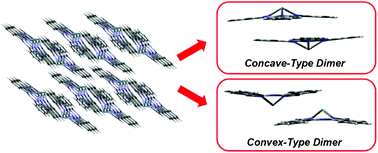Significance of dimer models describing physical properties in a triclinic solid of tin(ii) phthalocyanine†
Abstract
In order to study the solid-state electronic structures for ground and excited states of tin phthalocyanine (SnPc), we extracted two types of dimers and a trimer as model systems from the crystal structure of the triclinic polymorph. One of the dimers had a convex configuration between two SnPc molecules, and the other took a concave one. The trimer consisted of both configurations. The molecular geometries, electronic structures, and excitation energies of the concave- and convex-type dimers and the trimer were investigated using the M06 method of the density functional theory (DFT). The geometries of these model systems were optimized under C2h molecular symmetry for the dimers and under C1 for the trimer. The distances between two Sn atoms were optimized to be 6.805 and 6.374 Å for concave- and convex-type dimers, respectively. The corresponding distances in the trimer were calculated to be 6.959 and 6.457 Å, respectively. The Sn-Sn distances calculated for the dimers and trimer were consistent with the experimental values for the crystal. The energy diagrams of these model systems imply that each molecular orbital of an SnPc monomer forms the electron-energy band with a relatively large bandwidth due to strong intermolecular interactions in the solid state. The time-dependent DFT calculation for the trimer reproduced well the observed absorption spectrum in the solid state. It should be noted that a sum of the excited states calculated for the two types of the dimers reproduces the calculation results for the trimer well. From these results, it would be concluded that the electronic structure of SnPc for the solid state can be investigated by using these two dimers. The vertical values of the ionization potential (


 Please wait while we load your content...
Please wait while we load your content...